
Chapter 8 Bacterial genetics 9.1 Mutations and Mutants 9.2 Genetic Recombination 9.3 Genetic Transformation 9.4 Transduction 9.5 Conjugation 9.6 Plasmids 9.7 Transposons and Insertion Sequences 9.8 Comparative Prokaryotic Genomics 9.9 Genetics in Eukaryotic Microorganisms
Chapter 8 Bacterial genetics 9.1 Mutations and Mutants 9.2 Genetic Recombination 9.3 Genetic Transformation 9.4 Transduction 9.5 Conjugation 9.6 Plasmids 9.7 Transposons and Insertion Sequences 9.8 Comparative Prokaryotic Genomics 9.9 Genetics in Eukaryotic Microorganisms
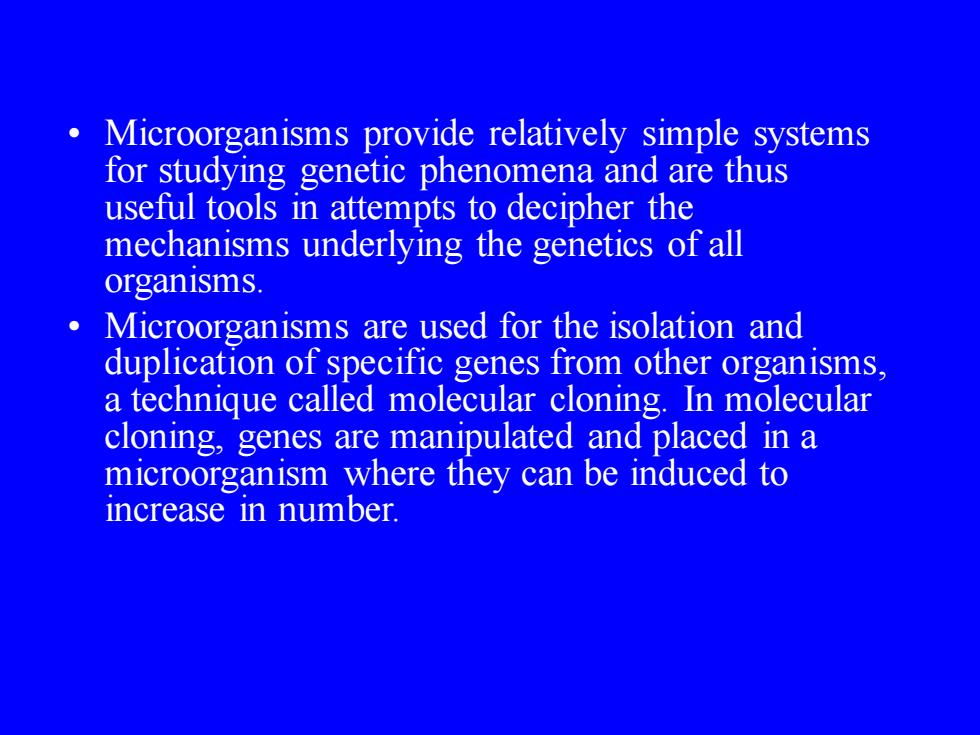
• Microorganisms provide relatively simple systems for studying genetic phenomena and are thus useful tools in attempts to decipher the mechanisms underlying the genetics of all organisms. • Microorganisms are used for the isolation and duplication of specific genes from other organisms, a technique called molecular cloning. In molecular cloning, genes are manipulated and placed in a microorganism where they can be induced to increase in number
• Microorganisms provide relatively simple systems for studying genetic phenomena and are thus useful tools in attempts to decipher the mechanisms underlying the genetics of all organisms. • Microorganisms are used for the isolation and duplication of specific genes from other organisms, a technique called molecular cloning. In molecular cloning, genes are manipulated and placed in a microorganism where they can be induced to increase in number
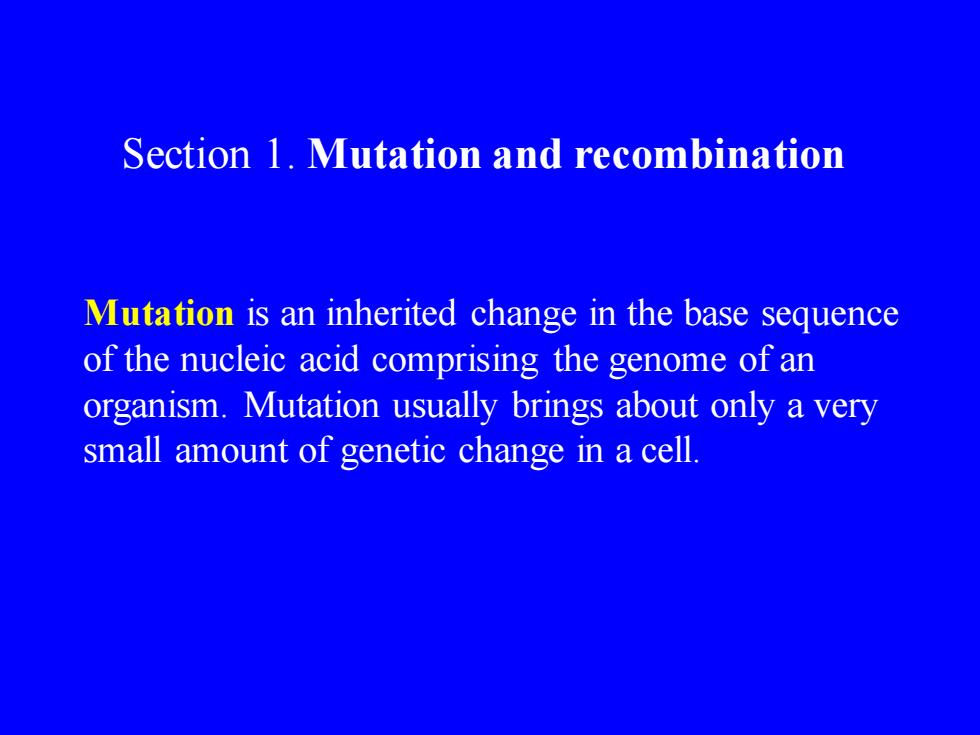
Section 1. Mutation and recombination Mutation is an inherited change in the base sequence of the nucleic acid comprising the genome of an organism. Mutation usually brings about only a very small amount of genetic change in a cell
Section 1. Mutation and recombination Mutation is an inherited change in the base sequence of the nucleic acid comprising the genome of an organism. Mutation usually brings about only a very small amount of genetic change in a cell
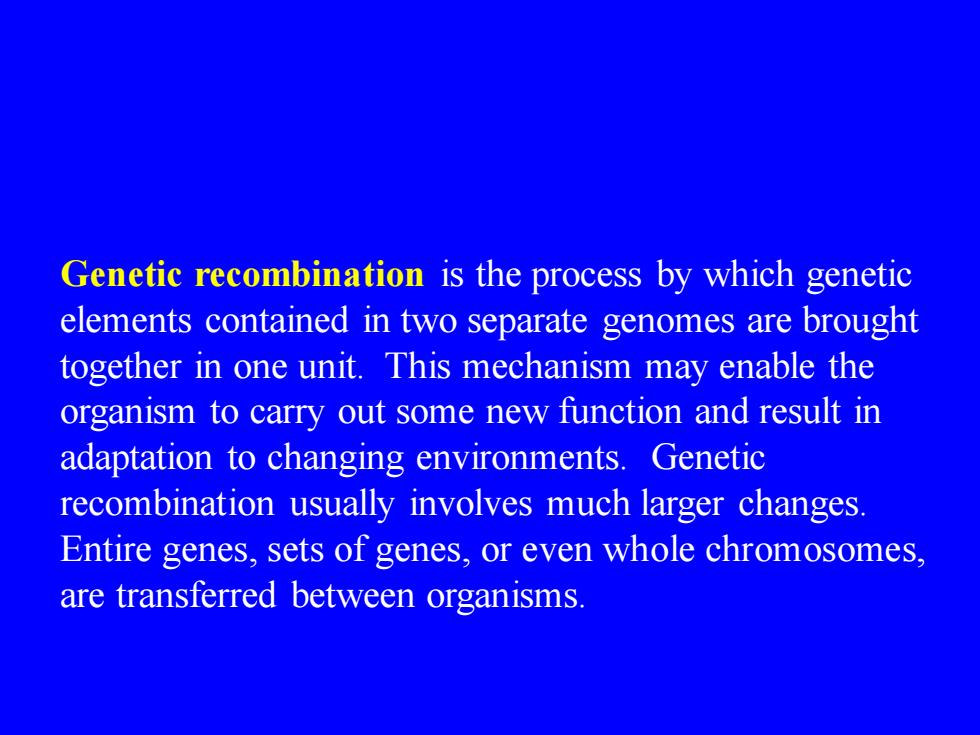
Genetic recombination is the process by which genetic elements contained in two separate genomes are brought together in one unit. This mechanism may enable the organism to carry out some new function and result in adaptation to changing environments. Genetic recombination usually involves much larger changes. Entire genes, sets of genes, or even whole chromosomes, are transferred between organisms
Genetic recombination is the process by which genetic elements contained in two separate genomes are brought together in one unit. This mechanism may enable the organism to carry out some new function and result in adaptation to changing environments. Genetic recombination usually involves much larger changes. Entire genes, sets of genes, or even whole chromosomes, are transferred between organisms
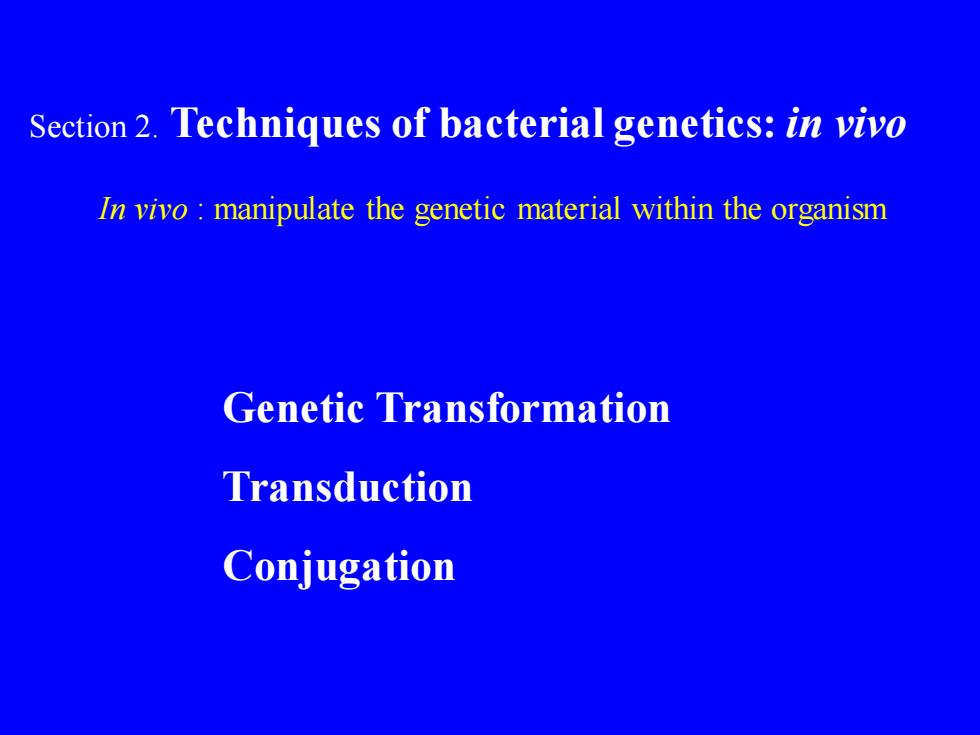
Section 2. Techniques of bacterial genetics: in vivo In vivo : manipulate the genetic material within the organism Genetic Transformation Transduction Conjugation
Section 2. Techniques of bacterial genetics: in vivo In vivo : manipulate the genetic material within the organism Genetic Transformation Transduction Conjugation
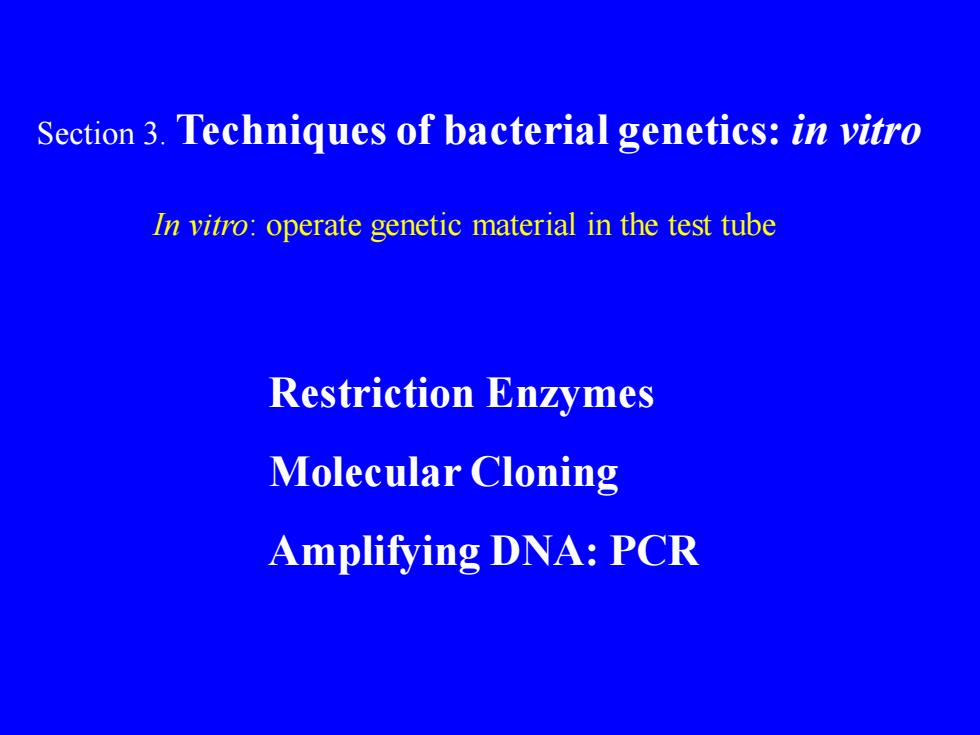
Section 3. Techniques of bacterial genetics: in vitro In vitro: operate genetic material in the test tube Restriction Enzymes Molecular Cloning Amplifying DNA: PCR
Section 3. Techniques of bacterial genetics: in vitro In vitro: operate genetic material in the test tube Restriction Enzymes Molecular Cloning Amplifying DNA: PCR

Auxotroph an organism that has developed a nutritional requirement through mutation Cloning vector genetic element into which genes can be recombined and replicated Conjugation transfer of genes from one prokaryotic cell to another by a mechanism involving cell-to-cell contact and a plasmid Diploid a eukaryotic cell or organism containing two sets of chromosomes Electroporation the use of an electric pulse to induce cells to take up free DNA Gene disruption use of genetic techniques to inactivate a gene by inserting within it a DNA fragment containing an easily selectable marker. The inserted fragment is called a cassette, and the process of insertion, cassette mutagenesis WORKING GLOSSARY
Auxotroph an organism that has developed a nutritional requirement through mutation Cloning vector genetic element into which genes can be recombined and replicated Conjugation transfer of genes from one prokaryotic cell to another by a mechanism involving cell-to-cell contact and a plasmid Diploid a eukaryotic cell or organism containing two sets of chromosomes Electroporation the use of an electric pulse to induce cells to take up free DNA Gene disruption use of genetic techniques to inactivate a gene by inserting within it a DNA fragment containing an easily selectable marker. The inserted fragment is called a cassette, and the process of insertion, cassette mutagenesis WORKING GLOSSARY

Genetic map the arrangement of genes on a chromosome Genome the total complement of genes of a cell or a virus Genotype the precise genetic makeup of an organism Hybridization formation of a duplex nucleic acid molecule with strands derived from different sources by complementary base pairing Molecular cloning isolation and incorporation of a fragment of DNA into a vector where it can be replicated Haploid a cell or organism that has only one set of chromosomes Mutagens agents that cause mutation Mutant an organism whose genome carries a mutation Mutation an inheritable change in the base sequence of the genome of an organism
Genetic map the arrangement of genes on a chromosome Genome the total complement of genes of a cell or a virus Genotype the precise genetic makeup of an organism Hybridization formation of a duplex nucleic acid molecule with strands derived from different sources by complementary base pairing Molecular cloning isolation and incorporation of a fragment of DNA into a vector where it can be replicated Haploid a cell or organism that has only one set of chromosomes Mutagens agents that cause mutation Mutant an organism whose genome carries a mutation Mutation an inheritable change in the base sequence of the genome of an organism
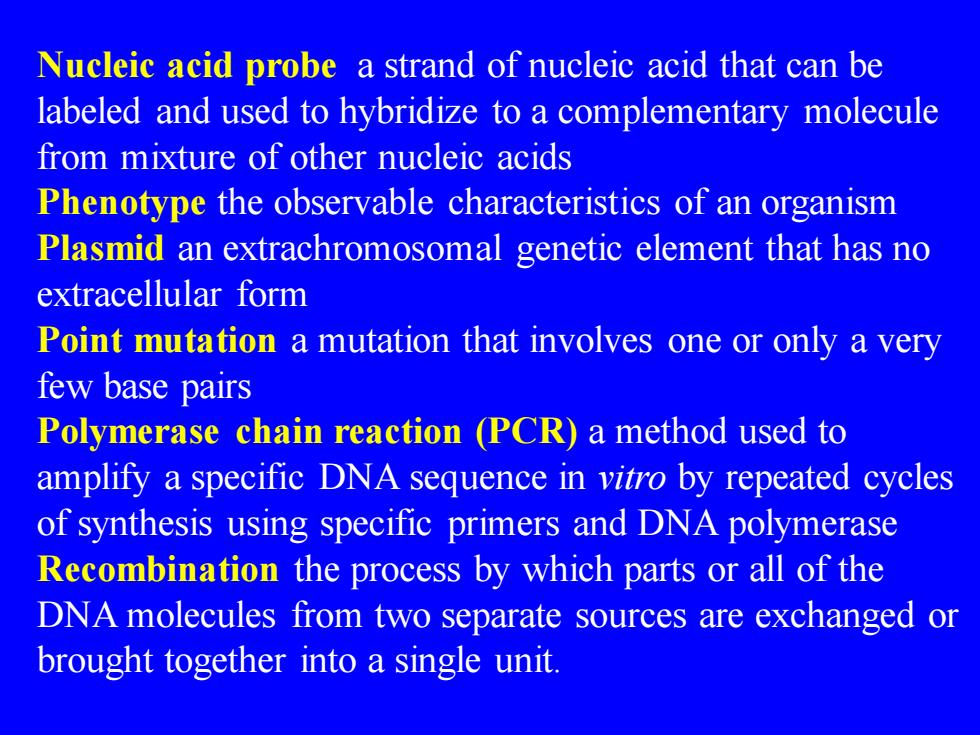
Nucleic acid probe a strand of nucleic acid that can be labeled and used to hybridize to a complementary molecule from mixture of other nucleic acids Phenotype the observable characteristics of an organism Plasmid an extrachromosomal genetic element that has no extracellular form Point mutation a mutation that involves one or only a very few base pairs Polymerase chain reaction (PCR) a method used to amplify a specific DNA sequence in vitro by repeated cycles of synthesis using specific primers and DNA polymerase Recombination the process by which parts or all of the DNA molecules from two separate sources are exchanged or brought together into a single unit
Nucleic acid probe a strand of nucleic acid that can be labeled and used to hybridize to a complementary molecule from mixture of other nucleic acids Phenotype the observable characteristics of an organism Plasmid an extrachromosomal genetic element that has no extracellular form Point mutation a mutation that involves one or only a very few base pairs Polymerase chain reaction (PCR) a method used to amplify a specific DNA sequence in vitro by repeated cycles of synthesis using specific primers and DNA polymerase Recombination the process by which parts or all of the DNA molecules from two separate sources are exchanged or brought together into a single unit
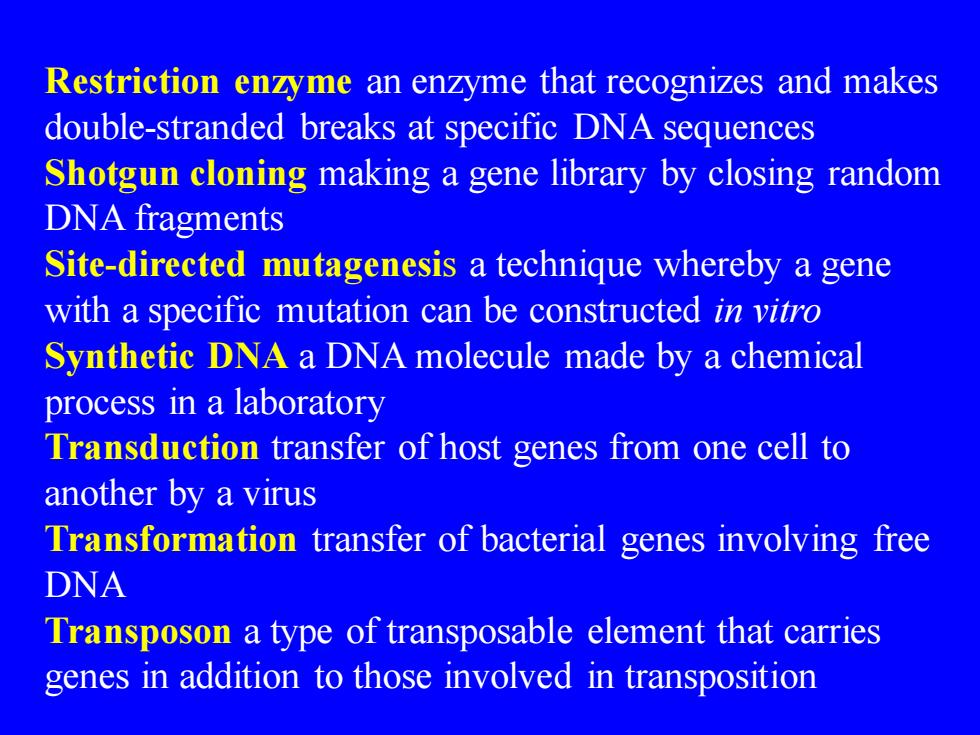
Restriction enzyme an enzyme that recognizes and makes double-stranded breaks at specific DNA sequences Shotgun cloning making a gene library by closing random DNA fragments Site-directed mutagenesis a technique whereby a gene with a specific mutation can be constructed in vitro Synthetic DNA a DNA molecule made by a chemical process in a laboratory Transduction transfer of host genes from one cell to another by a virus Transformation transfer of bacterial genes involving free DNA Transposon a type of transposable element that carries genes in addition to those involved in transposition
Restriction enzyme an enzyme that recognizes and makes double-stranded breaks at specific DNA sequences Shotgun cloning making a gene library by closing random DNA fragments Site-directed mutagenesis a technique whereby a gene with a specific mutation can be constructed in vitro Synthetic DNA a DNA molecule made by a chemical process in a laboratory Transduction transfer of host genes from one cell to another by a virus Transformation transfer of bacterial genes involving free DNA Transposon a type of transposable element that carries genes in addition to those involved in transposition